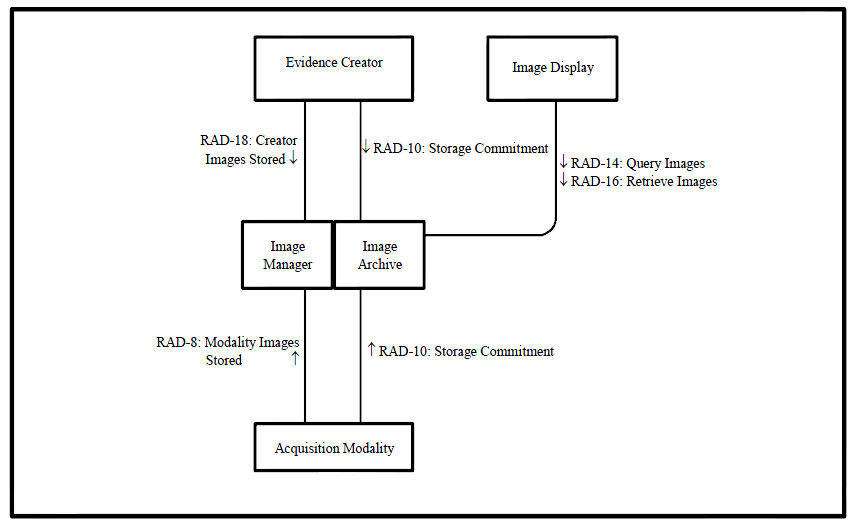Difference between revisions of "Mammography Image"
(Created page with "'''Mammography Image Image (NMI)''' specifies how Nuclear Medicine images and result screens are created, exchanged, used and displayed. __TOC__ ==Summary== The Nuclear Medicin...") |
|||
| Line 1: | Line 1: | ||
| − | '''Mammography | + | The '''Mammography Image (MAMMO)''' Profile specifies how Mammography images and evidence objects are created, exchanged, used and displayed. |
__TOC__ | __TOC__ | ||
==Summary== | ==Summary== | ||
| − | The | + | The Mammo Image Profile specifies basic '''display capabilities''' |
| − | |||
| − | |||
==Benefits== | ==Benefits== | ||
| − | |||
| − | |||
| − | |||
| − | |||
| − | |||
| − | |||
| − | |||
| − | |||
==Details== | ==Details== | ||
| − | |||
| − | |||
| − | |||
| − | |||
| − | |||
| − | |||
| − | |||
| − | |||
| − | |||
| − | |||
| − | |||
| − | |||
| − | |||
==Systems Affected== | ==Systems Affected== | ||
| − | * Modalities may create, store, and transmit | + | * Modalities may create, store, and transmit Mammography images. |
| − | * PACS systems may store, manage, and/or display | + | * PACS systems may store, manage, and/or display Mammography images. |
| − | * Display systems may query, retrieve and display | + | * Display systems may query, retrieve and display Mammography images. |
| − | * Workstations may retrieve, process and display | + | * Workstations may retrieve, process and display Mammography images, and may create evidence documents. |
'''Actors & Transactions:''' | '''Actors & Transactions:''' | ||
| Line 47: | Line 24: | ||
==Specification== | ==Specification== | ||
| − | '''Profile Status:''' [[ | + | '''Profile Status:''' [[Final Text]] |
'''Documents:''' | '''Documents:''' | ||
| − | :* [http://www.ihe.net/Technical_Framework/ | + | :* [http://www.ihe.net/Technical_Framework/] '''Underlying Standards:''' |
| − | |||
| − | '''Underlying Standards:''' | ||
:* [http://dicom.nema.org DICOM] | :* [http://dicom.nema.org DICOM] | ||
| Line 61: | Line 36: | ||
'''Related Profiles''' | '''Related Profiles''' | ||
| − | * [[Scheduled Workflow]] [SWF] can manage the production of | + | * [[Scheduled Workflow]] [SWF] can manage the production of Digital Mammography Images. |
| + | |||
| + | * Mammography Acquisition Workflow [MAWF] is handling exceptions occurring during the acquisition workflow like changing the acquisition room, handling of recall scenarios or converting procedures | ||
| − | * [[Patient Information Reconciliation]] [PIR] is expected to reconcile | + | * [[Patient Information Reconciliation]] [PIR] is expected to reconcile Mammography Images along with the rest of the patient data record. |
| − | * [[Reporting Workflow]] [RWF] may use | + | * [[Reporting Workflow]] [RWF] may use Mammography Images as inputs to the reporting process. |
| − | * [[Cross-enterprise Document Sharing for Imaging]] [XDS-I] can be used to share | + | * [[Cross-enterprise Document Sharing for Imaging]] [XDS-I] can be used to share Mammography Images between sites over a network. |
| − | * [[Portable Data for Imaging]] [PDI] can store | + | * [[Portable Data for Imaging]] [PDI] can store Mammography Images on media such as CDs. |
| − | * [[Import Reconciliation Workflow]] [IRWF] can fix patient ids, etc. of | + | * [[Import Reconciliation Workflow]] [IRWF] can fix patient ids, etc. of Mammography Images when importing. |
Revision as of 04:23, 25 July 2012
The Mammography Image (MAMMO) Profile specifies how Mammography images and evidence objects are created, exchanged, used and displayed.
Summary
The Mammo Image Profile specifies basic display capabilities
Benefits
Details
Systems Affected
- Modalities may create, store, and transmit Mammography images.
- PACS systems may store, manage, and/or display Mammography images.
- Display systems may query, retrieve and display Mammography images.
- Workstations may retrieve, process and display Mammography images, and may create evidence documents.
Actors & Transactions:
Specification
Profile Status: Final Text
Documents:
- [1] Underlying Standards:
See Also
Related Profiles
- Scheduled Workflow [SWF] can manage the production of Digital Mammography Images.
- Mammography Acquisition Workflow [MAWF] is handling exceptions occurring during the acquisition workflow like changing the acquisition room, handling of recall scenarios or converting procedures
- Patient Information Reconciliation [PIR] is expected to reconcile Mammography Images along with the rest of the patient data record.
- Reporting Workflow [RWF] may use Mammography Images as inputs to the reporting process.
- Cross-enterprise Document Sharing for Imaging [XDS-I] can be used to share Mammography Images between sites over a network.
- Portable Data for Imaging [PDI] can store Mammography Images on media such as CDs.
- Import Reconciliation Workflow [IRWF] can fix patient ids, etc. of Mammography Images when importing.
Consumer Information
The Profile FAQ Template answers typical questions about what the Profile does. <Replace the link with a link to the actual FAQ page for the Profile>
The Profile Purchasing Template describes considerations when purchasing equipment to deploy this Profile. <Replace the link with a link to the actual Purchasing page for the Profile>
Implementer Information
The Profile Implementation Template provides additional information about implementing this Profile in software. <Replace the link with a link to the actual Implementation page for the Profile>
Reference Articles
<List References (good and bad) (with link if possible) to Journal Articles that mention IHE's work (and hopefully include some analysis). Go ahead, Google: IHE <Profile Name> abstract or Google: IHE <Profile Name> and under the "more" select "Scholar". You might be surprised. >
This page is based on the Profile Overview Template
